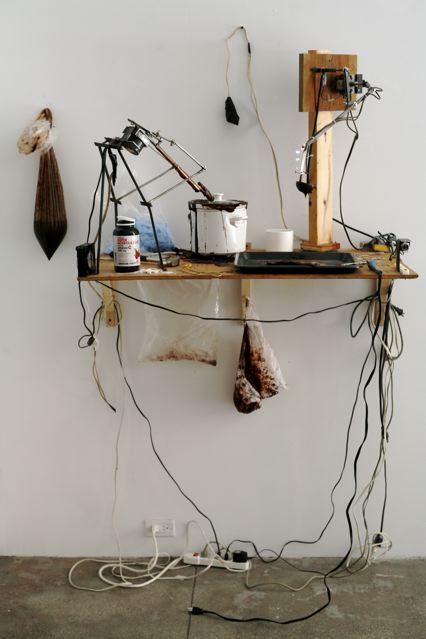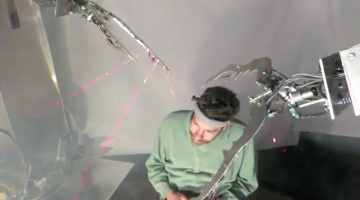One might say that the unassuming yet smooth talking Kal Spelletich is a graduate of the School of Hard Knocks, Magna Cum Laude. He was a teenage runaway that somehow managed to survive in the squats of Davenport, Iowa during the dreary days of the 1970’s. Needless to say he missed out on high school altogether. However, instead of becoming a goth or a poser in some underground scene—or a dead junkie, he used his skills from working at his father’s construction company to land a union job at 18. While in the United Auto Workers Union he became exposed to mass production and witnessed what it takes to build on a gigantic scale.
Leaving Iowa, he got back on track and enrolled in the University of Texas at Austin, where he earned an MFA. While there founded an art group called the SEEMEN with whom he put on art shows and generally caused trouble. He also helped start the Austin Media Arts Center which has educated countless students since then. During the late 1980’s, he lost a brother to AIDS and eventually moved to San Francisco.
One day some people from Survival Research Labs came to shows he was doing with the SEEMEN and that led to his working with SRL, making large-scale robotic performances with them and travelling around the United States and Europe.
Although for a long time the Industrial art culture and the so-called “fine art” cultures in San Francisco were very separate, they did overlap here and there. Spelletich, like artists Matt Heckert and Brian Goggin, was one of the few to build a solid bridge between the different scenes. Over the past few years he has had several gallery exhibitions of various contraptions, like a whiskey pouring machine & a walking barbeque at Jack Hanley in New York and now a series of Robotic portraits he has made of friends including Chris Johanson, Mark Pauline, Emory Douglas, and Martha Wilson at Catharine Clark Gallery in San Francisco.

Installation View, “Intention Machines,” Kal Spelletich at Catharine Clark Gallery, San Francisco, April 11 – May 29, 2015. Courtesy of Catharine Clark Gallery.
You used to make big, dangerous mechanical contraptions that exploded and shot out fire, but now you are showing in galleries. What’s going on? Have you sold out?
Don’t you have to get paid to sell out? For decades people told me what I did is not art, but I think of art as anti-Capitalist. That’s what I love about art making – that I can make things that are absolutely worthless to a market – things that are weird & only interesting to a small subset of people. Things that are for a small subset of people. That, and the fact that I do not give a shit what other people think. I see it as a workaround of Capitalism and it wonderfully confuses Capitalists.
Can you elaborate?
One time I had a show in New York and these guys in suits came up to me, asking, “Are you Kal? You made all of this stuff?” I’m like, “Yes.” Then they’re like, “Can you explain this mechanical linkage and why you made it this way?” I said “Sure…”, then I went into detail explaining why the linkage got more movement if I did it this way or that way. I showed how I had previously made it and how it was now way was more efficient, yadda, yadda. I could tell they understood everything I said, and then they made me a proposition, “Do you want to make some money?” So I was like “Sure!” But then they handed me their card and apparently they were defense contractors. I gave the card back right away and told them, “No way, I will not use my powers for evil.”
Right. Why not put artists to work by getting them to use their creativity to build weapons?
I have also gotten a couple of emails asking me to build a remote control tank with a flamethrower and for other mobile weapons systems and even a bomb defuser.
I guess making flame throwing tanks for the military would be more of a sellout than having show in a gallery.
Well, in the end I just don’t want to use this medium in such a polar opposite way than what my morals are. Each time that situation arises I shame them and ask how they can look themselves in the mirror while they’re cashing in on death.
Oh, they must love hearing that…
Then I tell them to use their powers for good and that I would rather to continue to eat out of a can of beans than eat their steak and lobsters.
Real artists are supposed to have a little sketchbook to try out their ideas, right? Do you keep sketchbooks?
Yes, and notes and whatnots. I love my notebooks. I am a firm believer in keeping a notebook, hardcopy.
At the same time, you’re not just an art guy, you’re a car guy too?
Yes, and motorcycle guy and bicycle guy.
Like can you open up a hood and diagnose an engine just by listening to it?
Usually. Well, with old, pre-computer cars, but now even the old mechanics can’t diagnose cars, not without a computer to diagnose the computer.
How did you learn how to be so mechanically inclined?
Oh, I kept at it, taking apart the family toaster, building boats and tree houses as a kid. I never thought of myself as a “natural,” but something about taking things apart and putting them back together genuinely interested me and still does. It is my practice.
Right. There is a certain kind of knowledge one only gets by making things and by having direct experiences.
I think everyone should be able to make things, grow things, fix things and cook.
How many tools do you own?
I have a nice smallish lathe. I do have a torch. I have a lot of hand tools. Really, if you have a jigsaw, screw gun and some basic hand tools, you can pretty much build a house.
Is your work really just about process and not so much about the final product?
Well, I definitely like to honor both the materials and the process. Show the “mistakes.” But at one point I realized that I could spend all year on just one robot or bust out ten of them in the same period of time.
So you’re not planning stuff way in advance then…the actual act of making the thing dictates the form of the artwork?
Well, I tend to make whatever seems important at the time. Ultimately I like to show how the piece works, and not cover it and slick it up. For some reason, when the machine works, I try not to decorate it. I reckon I got that from Duchamp.

Installation view, “California Investigative Healing,” Kal Spelletich at Jack Hanley Gallery, New York, 2009. Courtesy of Jack Hanley Gallery.
Funny you mention his name. I have met artists that think his work is total bullshit too – like he got away with robbing a bank or something. Have you ever encountered that attitude?
I feel sorry for folks like this, to miss out on the most important artist of the twentieth century, to just dismiss his ideas like that. But then again – I have a blue collar background and I know that most of the world thinks that fine art itself is some sort of con, some kind of bullshit, so there’s that.
Definitely. But it does seem like people feel conceptual art in particular is more full of shit than other kinds of art – maybe because conceptual artists selfishly want to get credit for all the effort they put into something?
Well, I do aspire to make conceptual work that looks good – that you can enjoy without having to read a book. In the end though, hopefully it intrigues you enough to want to read the “book.”
Maybe one of the things Duchamp, and the Surrealists, did, was to give us a vocabulary with which to talk about process?
That’s right. And a new approach to art making.
What they did was very political – left wing political – and also new…
They basically reinvented art and yet they couldn’t get shows or sales for the life of them. So they booked their own shows. In retrospect it was so DIY and punk rock of them.
Because you have such a fix-it guy persona, I’ve heard that people are often surprised how much you know about Marcel Duchamp. Why do you care so much about him?
HAHA! Busted, I am obsessed with him. He changed the game. I have read at least 15 books on him. He made machines, films, installations, found objects, went in drag, made conceptual art, did performances. He saw it all coming before anyone else.
What are the works of his you like the most, or that you find interesting?
I love his late works, Wedge of Chastity, Feuille de vigne femelle (Female Fig Leaf), Objet d’ard, Prière de toucher [Please touch], his optics machines.
All of those works are more like questions than answers. He and Man Ray both did that, they made work that didn’t have easy answers, especially works that dealt with the figure. They also used motors at some point to make kinetic art.
Yesirree!
But don’t you feel their work is more clever, more intellectual, sort of the opposite of where art is now.
I don’t know if I agree with that, there’s lots of intellectual art going on right now, perhaps even more than when Duchamp was alive. It was just done VERY WELL by them.
Right. Maybe it’s not done as well these days but there’s more of it. Duchamp and Man Ray were also incredibly witty and very funny.
They were having fun, a lot of fun. During the last 20 years of Duchamp’s life, he changed. People don’t talk about this much but he got “spiritual/mystical” or whatever. He believed art had this other/mystic power. It’s what I am trying to do with this show (at Catharine Clark Gallery).
And that’s why you are making these new works?
I started the project with a bunch of questions to see if I could answer them. Like – If we do not pray, can a robot do it for us? Can praying be automated?

Installation View, “Intention Machines,” Kal Spelletich at Catharine Clark Gallery, San Francisco, April 11 – May 29, 2015. Courtesy of Catharine Clark Gallery.
So these new constructions are not just meant to be put on a shelf, but for viewers to interact with? They don’t light on fire, but they do entertain…
Yes. They are inventions that extrapolate on concepts. They are all interactive. They make you engage. Art as experience. So much of the consumption of culture and life is passive, so I am rebelling against that passivity… messing with our presupposed ideas of what a robot should do for us and how it should respond or what it even is.
What do you say to people now when they tell you what you make is not art?
Oh, I still hear people ask, “This is art???” Personally, I like it. I tell them, “Well, maybe it is or maybe it isn’t or maybe the definition of art is changing.”



